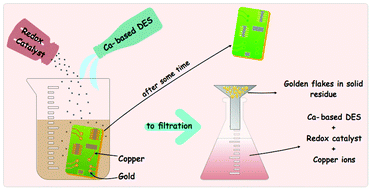Catalytic dissolution of metals from printed circuit boards using a calcium chloride–based deep eutectic solvent†
Abstract
Due to their high metal content, printed circuit boards (PCBs) are an attractive resource for metal recovery. Until now, the dissolution and subsequent recovery of metals from PCBs involve either pyro- and/or hydrometallurgy. Such processing routes are typically very energy intensive and generate large volumes of solid residues and wastewater, which require energy to be further treated and disposed. Thus, there is a need to develop more energy-efficient and environmentally-compatible processes. This study investigates the use of catalytic dissolution of metals from PCBs in a eutectic solvent formed from calcium chloride hexahydrate and ethylene glycol (EG) as a potential autocatalytic methodology for selective metal recovery from PCBs. Two oxidising agents, FeCl3 and CuCl2, were used as redox catalysts as both of them demonstrate high solubility and fast electron transfer. The catalysts selectively etched copper, allowing gold and nickel to be recovered by simple filtration. Leaching rates determined with an optical profiler showed that CuCl2 enabled faster leaching kinetics compared to FeCl3 and this is discussed in terms of the dissolution mechanism.

- This article is part of the themed collection: Precious Elements


 Please wait while we load your content...
Please wait while we load your content...